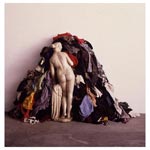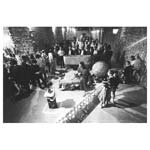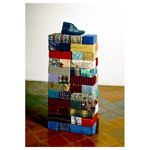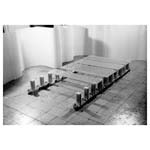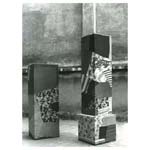Pistoletto is considered one of the leading exponents of Arte Povera. In the first place for his works: from the Minus Objects (1965-66), which preceded the official birth of the movement, in October 1967, to ones like the Venus of the Rags [Venere degli stracci] (1967), which have come to be seen almost as its emblem.
The Venus of the Rags was made with a concrete cast of the neoclassical sculptor Bertel Thorvaldsen’s statue Venus with the Apple, inspired by Praxiteles’s legendary Aphrodite of Knidos of 360 BCE. The first female nude in Greek art, it was lost and is only known to us through the innumerable copies of it that were made in the Greek and Roman eras and over the course of the following centuries. After buying a cast from a dealer in garden statues, Pistoletto brought it to his studio and set it against a heap of rags that he used to clean the surface of his Mirror Paintings. Thus the juxtaposition of the rags and the statue of Venus, placed with her back to the viewer like many of the figures in the early Mirror Paintings, produced a dialectic of a similar polarity to that of the Mirror Paintings themselves: a fixed figure, in this case the statue which represents an ideal of everlasting beauty handed down through the centuries, and a potentially infinite and always changing assortment of objects, represented by the rags, a symbol of garbage and decay. Many different meanings would be assigned to these rags over the course of time (consumerism, recycling, social exclusion) in parallel with the evolution of the reception of Venus of the Rags itself.
Other works with rags include Orchestra of Rags [Orchestra di stracci] and Small Monument [Monumentino], both from 1968. Orchestra of Rags is a multisensorial work that involves hearing and smell as well as sight, thanks to the sound made by the kettles and the bird-call whistles attached to their spouts and the odor produced by the effect of the steam on the rags. The first version of Small Monument, consisting of an old shoe set on top of a pile of bricks that were not yet wrapped in rags, could be seen in the action The Trained Man staged at Vernazza in May 1968. In the actions of The Zoo (a multidisciplinary group founded by Pistoletto and active from 1968 to 1970), moreover, rags were regularly worn by the members of the group, who got them from stocks of used clothing for recycling, and used as materials in the course of their actions. A second version of Small Monument, and the first in which bricks wrapped in rags appeared, was shown by Pistoletto in October 1968 at the Arsenal in Amalfi on the occasion of the historic exhibition “Arte Povera + Azioni Povere”, in which Pistoletto also used rags for a site-specific installation inside the ancient Roman ruins he found in his exhibition space.
Other important works of Pistoletto’s that are considered representative of Arte Povera are the ones he created with light and its reflections in December 1967 (Candles [Candele], Reflections on the Wall [Riflessi sul muro], Painting of Lightbulbs [Quadro di fili elettrici] and Curtain of Lightbulbs [Tenda di fili elettrici]), Water and Soap Sled [Slitta di acqua e sapone] (1968) and Labyrinth [Labirinto] (1968), this last made out of the same corrugated cardboard as was used in 1965 for Well [Pozzo], one of the Minus Objects.
No less important than the works was the role he had played as a catalyst since the early sixties in the group of Turinese artists—and as a bridge between them and the ones in Rome—who would give rise to the Arte Povera movement. The theorist of Arte Povera, Germano Celant, would acknowledge this function: “As an intellectual his role was that of weaving a European network of contacts among artists, facilitating the exhibition of Pino Pascali’s Weapons [in January 1966 in Turin] and improving the knowledge of Italian art by creating the Deposito d’Arte Presente [Warehouse of Present Art] and, subsequently, an artist’s collection, as well as making possible the dialogue among galleries, particularly Ileana Sonnabend and Gian Enzo Sperone, which led to the circulation of Pop Art in Italy and Arte Povera in France, Germany and the United States.”
(G. Celant, in Un’avventura internazionale [Turin: Charta, 1993], 14).
In this connection it is worth mentioning a number of exhibitions that predated the first occasion on which the term “Arte Povera” was used, “Arte Povera – Im Spazio”, curated by Celant and held in September 1967 at the Galleria Bertesca in Genoa. These were the exhibition “Gilardi, Pistoletto, Piacentino, Fabro” at the Milanese branch of the Galleria Sperone in December 1966; the exhibition “Flavin, Rosenquist, Chamberlain, Warhol, Fontana, Pistoletto, Gilardi, Piacentino, Fabro, Pascali, Anselmo, Zorio” at the Galleria Sperone in Turin in April 1967, which showed the work of some of the future members of the Arte Povera movement in Turin, Rome and Milan alongside that of American exponents of Pop Art and Minimal Art; and the historic exhibition entitled “Lo spazio degli elementi. Fuoco, immagine, acqua, terra”, at Fabio Sargentini’s gallery L’Attico in Rome in June 1967, with works by Bignardi, Ceroli, Gilardi, Kounellis, Pascali, Pistoletto and Schifano.
The Deposito d’Arte Presente to which Celant refers was the pioneering experiment carried out between the end of 1967 and the first half of 1969 in a large space, a former garage, that some Turinese collectors and businessmen, coordinated by collector Marcello Levi, had rented in response to a proposal by Pistoletto and Sperone. The idea was to place it at the disposal of artists so they would be able to work and exhibit in a space that suited a new kind of creativity, one that was not subject to the laws of the market. The exponents of Arte Povera used it to do their work and to put on exhibitions, performances and theatrical productions. It was there on December 16, 1968, that The Zoo, together with the MEV group, staged the performance of theatrical and musical improvisation called Play, preceded the day before by a musical procession, Canopy Theater, through the streets of Turin city center.
The collection mentioned by Celant, on the other hand, was the one of works by exponents of Arte Povera that Pistoletto bought and put on show, between 1970 and 1971, in a large apartment on Via Provana in Turin, rented by Pistoletto in those years for the purpose and utilized simultaneously as an exhibition and living space.

